Dubia roaches, also called Guyana orange spotted cockroaches, are one of the most known insects used as a food source for zoo animals. They are an excellent feeding source, especially for animals that require larger insects. Think of mongooses or primates, but numerous reptiles favour them as well. Many suppliers can deliver cockroaches in constant and large quantities, but it may be interesting to breed them yourself. They are easy breeders when you maintain your dubia colony in good condition. This practical guide increases your prospect to create a self-sustaining cockroach breeder colony to use as feeder insects for other animals in a zoo and animal facilities. This guide contains information on how to care for them, how to house them, and to make an easy set up for breeding cockroaches to maximize your supply of a healthy food source. Make yourself ready to breed dubia cockroaches successfully with this easy how-to guide.
Breeding versus buying
It is easy to buy (dubia) cockroaches at many of the animal food stores. Often they are quite cheap as well, so you need to make a reasonable consideration if you rather buy them or want to breed them. But be aware that when you buy them, you need to take care of them until they are fed as well. However, there are more benefits by breeding them yourself. One of the significant pros is that you know precisely how well-nourished they are, and therefore how nutritious they are to the animals you feed them. Because they are fed continuously without the interruption of transporting them from the shop to your facility or home, and along with different diets, they will be in better overall health. Another significant advantage is that you have the flexibility to grab every size of roach you need at that moment. When you have young animals, you can use the smaller nymphs to feed. When a new animal arrives, you don’t have to change the quantity you usually order at the shop. And especially with larger facilities with many animals, this can become very handy. Lastly, roaches are an exciting food source to use as enrichment. It can stimulate hunting behaviours for many animals, or in slow feeders encourage longer foraging time. Depending on your facility and your situation, breeding roaches can be very beneficial. So let’s dive into it, right?
Caution: Allergy risk for dubia cockroaches
It is essential to realize that allergic reactions have been recorded to (dubia) cockroaches, or their faeces, shedding body parts or saliva. It is not common, but when you take care of them on a day-to-day basis may result in the development of an allergic reaction to cockroaches over time. So when you keep a colony pay attention to irritation of the skin, eyes, nasal congestion, coughing or sneezing more in the proximity of cockroaches. Also, when having asthma, you may be affected more to an allergic reaction. When you take care of them daily, we advise you to wear disposable gloves and face mask to decrease the risk of developing an allergy to cockroaches.
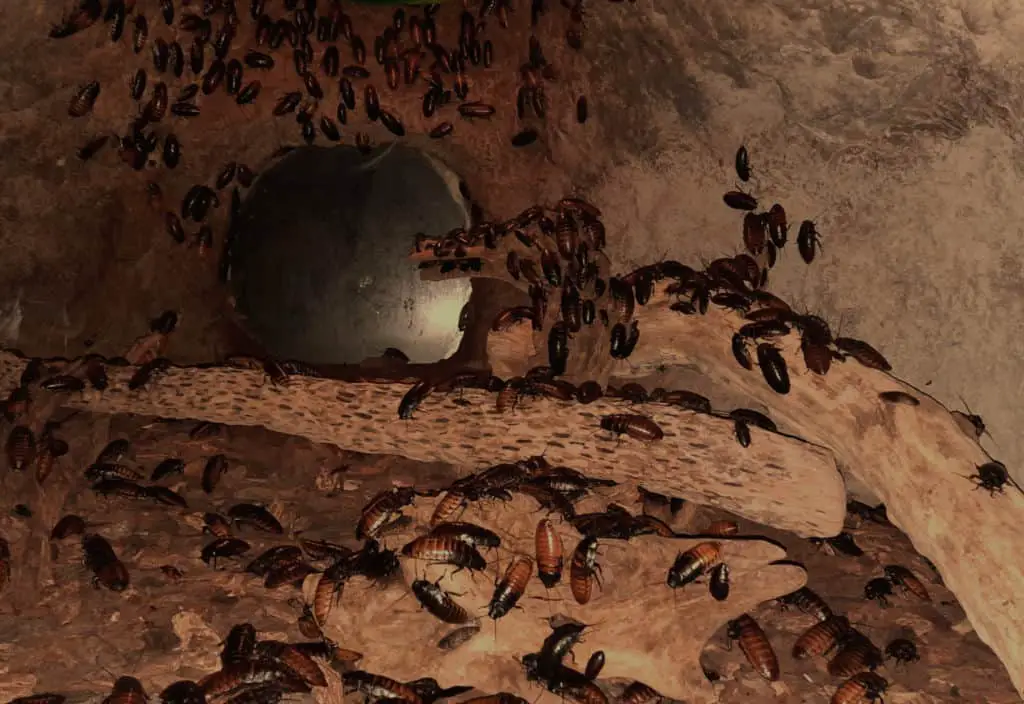
Focussed on dubia cockroaches, but what about other species?
Dubia cockroaches are the most known species of cockroaches and are often used to feed the animals. However, more species of cockroaches can be used as a feeder insect. The cockroaches that are best known and proven to be successful to feed are: Death’s head cockroach (Blaberus craniifer), red runner cockroach (Blatta lateralis) and the Madagascar hissing cockroach (Gromphadorhina portentosa). Every cockroach has its own best conditions to breed with them, but the setup as illustrated below can be used to breed death’s head cockroaches and Madagascar hissing cockroaches as well. In this guide, we focus on the more popular breeding of dubia cockroaches.
The reason for this? We already talked about many wins earlier. But when compared to crickets, and they are also easy breeders, dubia’s have some wins over crickets. Dubia cockroaches don’t smell and are almost odourless (except the food you provide). They don’t make any noise what also make a reason why they are in favour. Where crickets are prone to escape and can infest your location, dubia cockroaches are pretty slow, flightless and can’t escape from smooth surfaces like glass or slick plastic. They are livebearers which relieve you from all labour around hatching eggs and set up good egg environments. They also tend to be remarkably clean and problem-free. But still, proper preparation will give you a higher probability to successfully breed dubia roaches.
Good practice tip: This practical guide focusses on breeding dubia cockroaches, but can also be useful for breeding other types of cockroaches as well. Be sure to adapt the environment, husbandry and nutrition to the species you focus on.
Be prepared before you begin
When reading this you need to decide, or already have decided, to breed dubia roaches instead of buying them. But what are you breeding them for? This question sounds simple and obvious. You want to breed them to feed to other animals. Though, ask yourself this: how many animals do you want to feed roaches? Is it a crucial part of the animal diets, or can it occasionally be replaced with other food sources? Do you have a plan in the event you end up with too few roaches? And what if you have too many? A prepared start is half the work. It can be of great benefit to decide what you want from your dubia breeding colony before you start. Think about the time, resources, supplies and space you want to dedicate to your colony.
Good practice tip: Be prepared is half the work. Make sure you plan ahead before starting a breeding colony.
How-to create a suitable environment for a breeding colony
A colony needs a suitable environment to get the best breeding productivity, and a good location contributes to this. The ideal place to set up your breeding bin(s) is a location that has adequate light/dark cycle, have enough air circulation, has the correct ambient temperature & humidity, and is absent from loud noises or frequent disturbances.
Good practice tip: The dark hours are more important to dubia roaches that the light hours. Darkness is an important factor for an optimal breeding result.
Select a location
The best location has an ambient temperature between 15 and 25 degrees celsius (60 and 80 °F). This ambient temperature is lower than the ideal temperature in the breeding bin because it prevents overheating. Ambient humidity should be around 40-60%. There needs to be a good air circulation to make sure there is enough ventilation in the breeding bins. A light cycle of 12/12 is fine; the dark hours are more important than the light hours. You can use natural lighting, but you should never have direct sunlight on the dubia enclosures because this can cause overheating of the dubias. But breeding colonies are just doing fine with artificial lighting. Dubias like the dark more and when it comes to breeding, there is no such thing as too much darkness. Adjusting ambient parameters is more manageable in smaller areas than large ones. So, choose a location that is big enough for your enclosures and to work comfortably, but not too large of a space to manage.
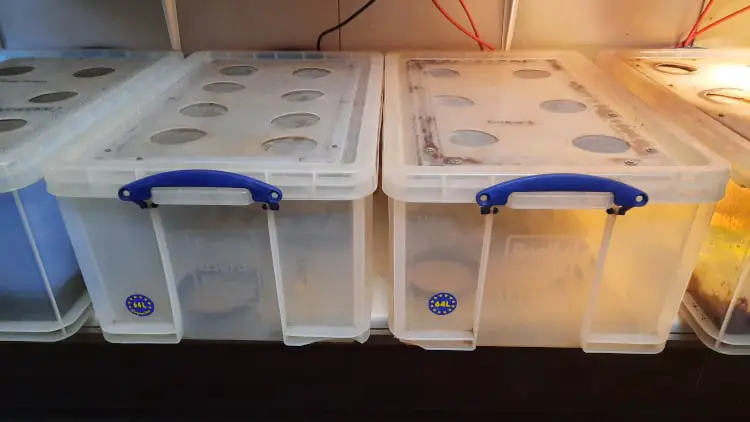
Enclosure bins and size
To house a breeding colony in good condition, one of the most important components is a suitable container. The best option is using plastic storage boxes, and preferably that they are stackable and are included with a lid. Glass can work as well, but plastic reduces the loss of temperature, is lighter and won’t break that easy. This way, it is easier to clean and to move around.
Smooth surface is a must-have to prevent escaping. So be aware that when you buy a plastic bin that the sides don’t have any texture. Usually, you can say that if the walls shine or have a glance, it is smooth enough that roaches will not be able to climb. I recommend always to buy a bin with a lid, even if you don’t plan to use it. You’ll never know if you need it in the future for unforeseen circumstances or if your setup changes. However, if you have smooth walls, a lid to prevent escaping roaches is not necessary. Dubia roaches don’t hop and don’t fly and won’t be able to climb out (as long as your furniture is not providing any chance). On the other hand, a cover also prevents that unwelcome animals (pets or other insects) can come in or stuff that falls in.
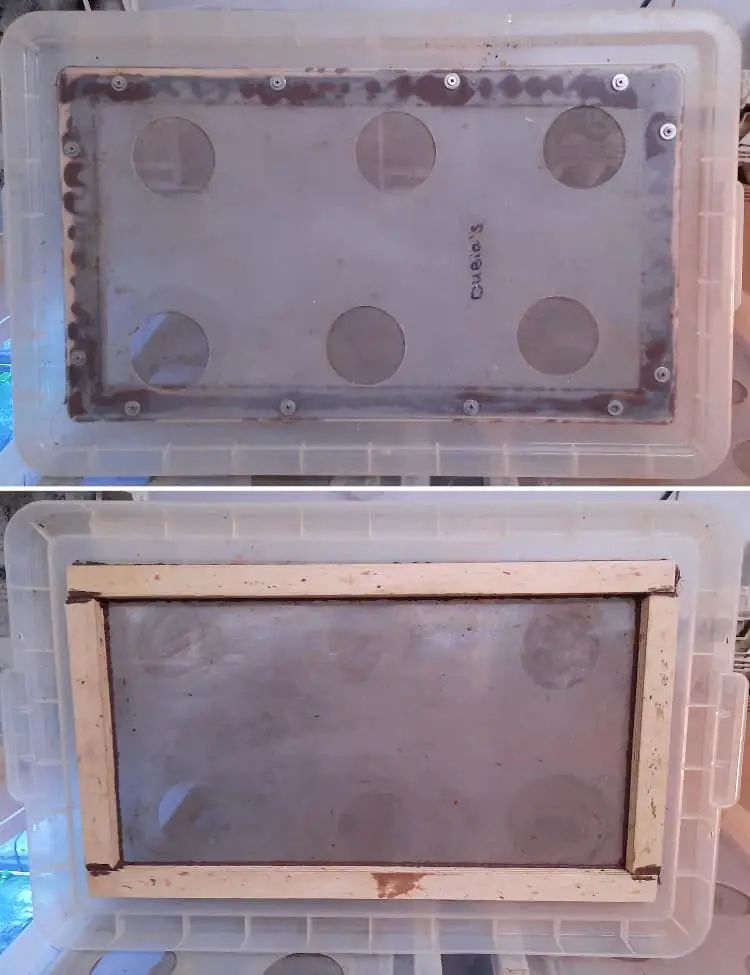
When you plan to use a cover lid, you must allow ventilation. We suggest to drill holes in it and cover it with metal window screen secured with either hot glue or with wood or metal frame. If you use fibreglass screen or plastic screen to cover these holes is fine, but be aware that dubias can chew through these materials. If you rely upon that the screen prevent escapes, you need to choose metal.
To determine the size that you will need for your enclosure, you can use the ratio of max 200 roaches / 0,1m² (or 200 roaches / 1sqft). It is better to start with an enclosure bin where you can ultimately house the number of roaches you plan to keep (see: plan your colony), however, it needs to be manageable too. Don’t buy or build a too big of an enclosure. It would be better to house them divided in multiple enclosures.
Good practice tip: A large enclosure bin can house many dubia roaches, but it needs to be manageable too. If you want to breed with many roaches, it may be better to house multiple breeding colonies.
For a good setup, I can recommend from my own experience the ‘64 litre Really Useful Box Plastic Bins‘. These high-quality bins are sturdy, durable during higher temperatures and conditions, have a smooth surface and are easy to work in.
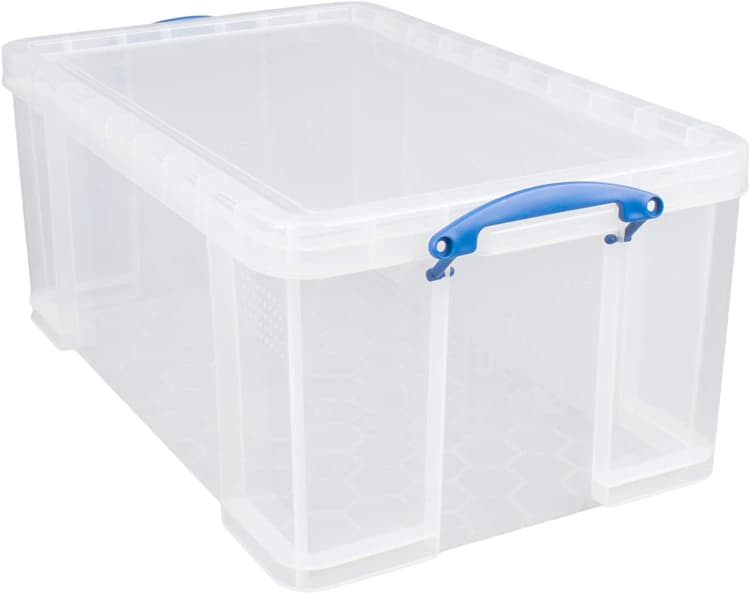
Environmental parameters – Temperature and humidity
To boost dubias for breeding, you need the best environmental conditions for them. The correct temperature and humidity are vital to have a high production outcome of your colony. We already talked about the ambient environment where you place your enclosure bin. Now we take a look at the local parameters.
Good practice tip: Temperature is one of the most important factors for a good breeding result. Make sure you have your temperature set up correctly!
Temperature and heating
Cockroaches are known to be survivalists, surviving a large range of environmental condition. However, fertility rapidly decreases to almost non-existing when you do not keep them within the temperature range between 28-32 degrees celsius (85-90°F). If the temperature dips lower, it slows down your dubias. If the temperature reach above 32°C (90°F) will cause heat stress and can ultimately kill your dubias. It is unlikely that you have a space to set up your enclosures that stays within this temperature range, so you’ll need additional heating to reach these temperatures. Heating can be done in several ways, but most commonly used are light bulbs, heat mats and heat cables.
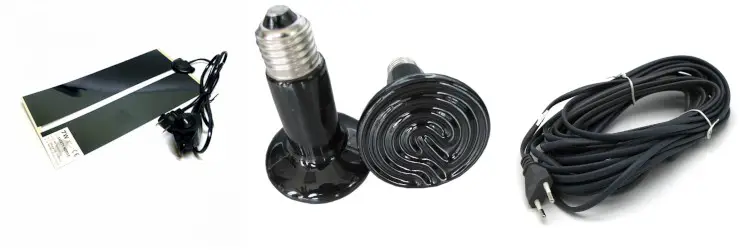
Good practice tip: If you need to heat your enclosure a lot to get the right temperature, the humidity may dip to a (too) low level and dry out the enclosure.
All heat sources need to be installed outside the enclosure, so there is no direct contact possible between the roaches and the heat source. Which heating is used depends on your situation, but I have a preference for heat mats. The advantage of heat mats is that it gradually and evenly heats the enclosure, does not generate light, and does not reach temperatures that easily melt or burn plastic. Be sure to leave a small space between the heat mat and enclosure bin so the heat can leave and prevents overheating. On the other hand, to be sure and safe, it is good practice two provide two types of heat sources. If one fails, you have one backup heat source remaining. But you can avoid harmful low temperatures by having a higher ambient temperature. A higher ambient temperature has one more advantage. When you need to heat a lot to get the enclosure to the right temperature range, the humidity may dip to a low level and dry out your enclosure. It is better to have higher ambient temperatures to keep your humidity level more steady.
Good practice tip: Make sure if you are using a heat lamp it is out of reach for roaches to get burned or that furniture is not touched to prevent unsafe situations.
Another point considering is regulating the temperature with a thermostat. It is not per definition necessary, but it makes it easier to control the temperature to fall in the optimum range. And, besides, thermostats are relatively inexpensive and widely available. So it would be a wise decision of having one to avoid catastrophic consequences to your colony.
Humidity
To breed with your dubia cockroaches, you’ll need to keep the humidity between 40% and 60%. A higher humidity level is acceptable, but you should avoid humidity lower than 40%. When the humidity drops lower than 40% the ootheca (egg capsule) tend to dry out and make the roach infertile. Females will drop their eggs and start making new ones. It also affects the development of nymphs. They too dry out faster and will eventually not survive. And in general, it seems like roaches have more trouble moulting their shells.
On the other end of the scale, humidity that is too high (especially higher than 80%) may give some problems too. An excessively humid environment in combination with a high temperature, darkness, and frass will result in mould and the growth of bacteria. Mould and bacteria growth is bad for egg production, development of nymphs and eventually also bad for you as a keeper. So keep that humidity up, but preferably between that range.
Good practice tip: When the humidity is too low, it may cause ootheca and nymphs will dry out. When it is too high may result in moult and bacteria growth. It is best practice to make your ambient humidity fall between 40% and 60% soo you don’t have to moisten your enclosures.
Be gentle with using water to raise the humidity. You can increase the humidity in several ways. You can use a larger water bowl for the roaches, place a water bowl near the heating source, mist spray some water, or use a humidifier. Whatever method you choose, increase it with little steps, so you do not moisten too much. In my experience spraying mist, or use a humidifier, is too much for the enclosure. I prefer to use a bowl filled with water that slowly damps to increase the humidity (with other words to increase the ambient humidity of the location).
Monitoring environmental parameters
The ranges for temperature and humidity are quite narrow, and therefore I can recommend monitoring these parameters. You can use a simple thermometer, hygrometer, or one that combines these two. You have one already for quite cheap. You’ll also have systems that register the minimum and maximum temperature and humidity.
Good practice tip: The number tells the tale. It is good practice to monitor environmental parameters to make sure your breeding colony is housed in good condition. Measuring equipment doesn’t have to be expensive and difficult, so there is almost nothing to lose.
If you rather want a more professional system to monitor your enclosure (or even enclosures), you can use wifi temperature and humidity loggers. A system of this last category that I can highly recommend is the ‘Tempro Wifi Temperature & Humidity Datalogger‘. This system monitor and logging temperature and humidity and can even give alarms for exceeding the minimum or maximum limits (also by e-mail). Another system that works well when you have multiple breeding bins is the ‘Renkforce Wireless Thermo-Hygrometer‘. Whatever monitoring system you choose, it would be best practice to monitor temperature and humidity to keep your breeding colony in the best condition.
Setting up the breeding bin (internal setup)
Now it is time to set up the breeding bin(s) to house dubia roaches. Actually, the internal setup is quite simplistic. It consists of three parts: water source and food source on one side, and shelter on the other. The water and food source will be discussed later on. What about a substrate? You don’t need to add any substrate. It doesn’t add any perk and, in contrast, make cleaning only more complicated.
Good practice tip: Paper egg flats are the holy grail when keeping dubia roaches as well as other insects like crickets and mealworms. Try to contact local stores to get them for free!
Paper egg flats are the classic shelter for dubia roaches. Actually, there is nothing that equally works to shelter roaches as egg flats. Egg flats are fantastic because of the rough texture and the way it creates tide spaces for the roaches to live in. These tide spaces create a dark shelter and increase surface for your breeding colony to house more roaches. You can use other types of paper and carton boards, but I can heartily recommend egg flats and won’t discuss other types of shelter here. Egg flats are available online, for example, on Amazon. As a zoo or animal facility, however, you sometimes can get them for free from some stores if you ask nicely.
The best way to use the egg flats is to pack them vertically side by side. This way, it allows frass/faeces to fall to the bottom and keeps the egg flats clean. Additionally, it doesn’t accumulate moisture when having them vertically. And somewhat strange, but when egg flats are put horizontally, roaches chew through it more quickly. Egg flats collapse into each other and to create the right spaces you need to pack each consecutive flat in a reverse direction: or front-to-front and than back-to-back or each turned 90-degrees. If your bin is not high enough, you may cut the flats to the right size. Make sure there is enough room to reach for your water and food source, and that it not pollutes the roaches’ shelter.
How-to feeding your dubia roaches
Nutrition is one of the pillars of good health and physical condition. And good health and physical condition contribute to excellent productivity and breeding result of your dubia roaches. Healthy roaches live longer, and females have larger broods. Additionally, offspring will have lower mortality rates and grow faster to fertile adults, which in turn are also more prolific.
Water
Not only does providing water help to increase the humidity, but water is also essential to hydrate the roaches themself. Especially newborn nymphs need instant access to water. They can quickly dehydrate and result in death. However, you can’t just provide a bowl with water. If you do that you’ll find many dead roaches drowned the next day. The best way to provide water is by putting a sponge or aquarium filter medium into a shallow bowl. In that way, the roaches can’t drown anymore. Be careful when choosing a sponge, that it does not contain any chemicals. I prefer the aquarium filter medium because you can be sure it is safe for the animals. Use a water bowl with rough edges so that they can easily climb onto the bowl.
Good practice tip: Make sure you roaches can’t drown. Using aquarium filter mediums works perfectly to prevent roaches from drowning and because they do not contain any chemicals as sponges often do, is also very safe for them.
You’ll need to change the water daily to keep it fresh. In some regions or countries, they put low doses of chemicals into tap water to improve water quality. For us humans, this is no problem; however, it can kill your roaches, sometimes even by the many. In that case, it is better to provide distilled water or bottled water without additives.
Providing water crystals is another method that can be used to hydrate insects like cockroaches. It is an absorbent polyacrylamide hydrogel that absorbs many times its own weight in water. However, it is more work to keep the crystals in good condition and when not get enough attention can rot or lead to other problems. Personally, I’m not a real fan of them, but many people tend to use them and are completely satisfied with them. So it’s up to you if you want to use them.
Food selection
Roaches are opportunistic scavengers that have simple basic needs. Dubia roaches, therefore, eat almost anything you give them. In general, you can feed them with most vegetables and fruits, but also whole-grain bread, cereal grains, and oats. Roaches particular like oranges and other orange foods. However, don’t feed them only oranges but use variation. Make sure you don’t offer them too much protein (see also the section further below).
Preformulated insect diets and gut-loading
There is a myriad of preformulated insect diets you can choose, but it would be best to select the ones that are explicitly formulated for dubia roaches. Also, in this case, watch out for diets that contain high levels of proteins, as will be explained below. Nevertheless, always feed them fresh fruits and vegetables next to these preformulated diets.
Gut-loading, at its basic level, is simply feeding some fruits and vegetables of any kind to make the roaches well-fed. However, better would be to feed products that are considered as “generally healthy” for the target species that ultimately eat the roaches. So, instead of looking only at products, it has (also) a focus on macro- and micronutrients. Think of calcium level, vitamin level, carbohydrates, etcetera. In the end, it is essential to have healthy roaches, so it makes healthy feeder insects. General nutritional needs of cockroaches should be met by providing a variety of grains, fruits, and vegetables and can be supplemented with preformulated diets.
Caution for high protein in the diet
Dubia roaches are very efficient in processing proteins. They can store proteins that they do not immediately use as uric acid, so they can use it again when they need it. Uric acid is toxic in high levels. It is known to cause gout and kidney stones to animals, and when continually fed high levels cause death. Be that as it may, you don’t need to feed them high protein food altogether. They are already a high protein feeder insect. If you just feed foods with normal levels of protein and enough variation, you don’t need to worry about toxic uric acid level, especially when also fed other insects to the target animal. A level of 25% protein in the diet seems like an “ideal” to target when feeding roaches. Also, give them enough water to hydrate. It seems like this will help to reduce uric acid levels as well.
Nutritional value and comparison with other feeder insects
Dubia roaches are very nutritious to other animals. Barrow-Agee laboratory (Tennessee) determined that dubia roaches have a nutritional value of 65.6% moisture, 23.4% protein, 7.2% fat, 2.9% fibre and Ca:P ratio of 1:3. There are not many other feeder insects that have such protein levels as feeder insects. For a complete comparison to other feeder insects see the table below.
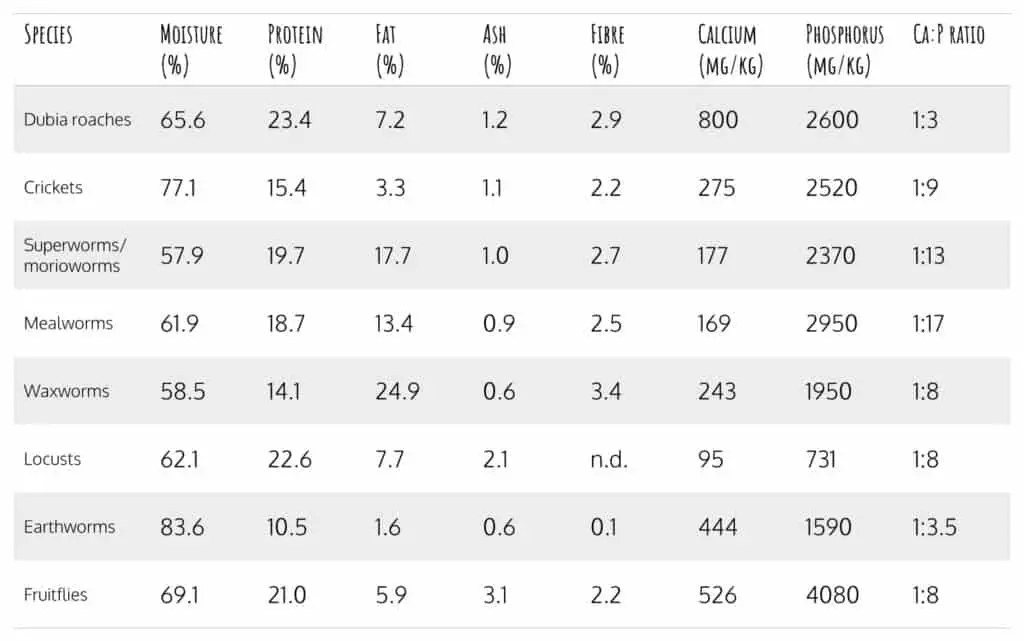
How-to manage your breeding colony
Now it is time to start a breeding colony. Below are the steps to follow to let you succeed and get the most of your breeding colony. We already talked about planning before you begin. You should know by now what housing is best and which food items you should feed the roaches. That is our starting point, and from here, we will go step-by-step on creating and managing a dubia roaches breeding colony.
Step 1. Plan your colony
First, you need to determine how many dubia roaches you want to feed. This amount is your main goal for starting the breeding colony. If you know that amount, you can roughly extrapolate how many roaches you need in your colony to provide that and to keep self-sustaining. If it is not many roaches you need, then it is best to start with 20 breeding females. If you have many animals that are fed with cockroaches, you’ll need more like 50 or 100 breeding females. As a rule of thumb, it is good to start with 50 breeding females. It takes some time to establish a self-sustaining breeding colony and to fine-tune all parameters to keep them in the best condition possible. Especially in the beginning, it would be good practice to select a maximum amount that you can miss from your starting colony that can be fed to the animals. With other words, that you don’t feed to many roaches, so you’ll keep your colony self-sustaining. The key is to continually keep this starting amount of breeding females, so also replace them with your descendants when breeding females die.
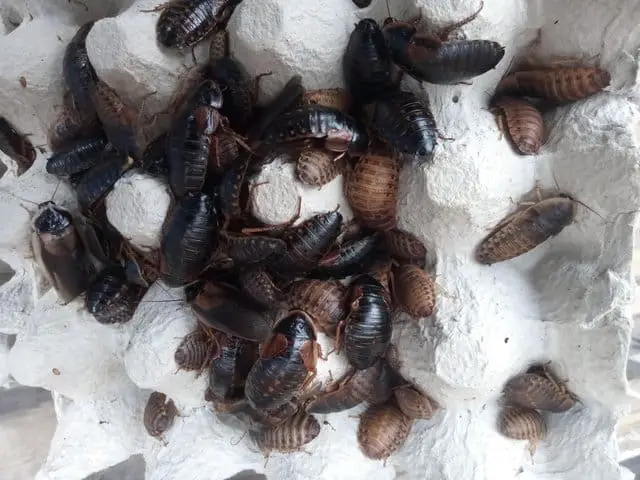
Step 2. Start your colony
Set up your breeding bin(s) to receive your first breeding colony. You can buy your first dubia roaches at an animal store or insect dealer, or get them from other (large) breeders. You can even get dubia roaches from Amazon if you want. When you receive your colony, you need to aim to get a male to female ratio between 1:3 to 1:7. Between these ratios, you’ll get the best breeding result. In other words, in the beginning, you’ll just have what you have. But after raising the first generation nymphs, you’ll slowly need to select to this ratio in your breeding colony. So you can feed the sexes that you’ll have an excess of at that moment. At some stores, you can select how many males and females you want.
Step 3. Cleaning enclosure bins
You’ll need to clean the enclosure bins regularly. Cleaning is pretty easy, also because there is no substrate. When cleaning the bin, you’ll have to remove the excessive frass, old skins, food remains and dead roaches.
You can make this easier by temporary placing the egg flats in another bin while cleaning because most roaches will stay in there. What also works very well is having one enclosure bin extra, so that you can move a colony in this clean enclosure and afterwards make the current enclosure clean again. Then you have one clean enclosure ready yet for the next cleaning session.
Good practice tip: An extra enclosure to rotate your colonies while cleaning can be very handy. It makes cleaning more efficient and less disturbing to your colony.
When removing frass, be careful not throwing out too many nymphs that hide in it. You can use a bucket with small holes in it to shake and separate the frass from nymphs. The frass will fall down the holes separating the roaches. Nymphs that have just emerged are known to hide in the frass and eat from it, so never throw all the frass away when cleaning.
You don’t have to replace the egg carton flats every time you’ll clean a bin. If you have put your egg flats vertically, they can last a long time, because they don’t accumulate frass and/or moisture. Egg flats absorb moisture. Humidity is, therefore, the main factor of the egg flats longevity. With higher humidity, the egg flats need to be replaced more often.
Step 4. The breeding cycle and breeding outcome
Understanding of the longevity and breeding cycle is essential to predict your breeding outcome better. So let’s have a look at that first.
How long do dubia roaches live?
From birth to adulthood, dubia roaches have seven growth phases. Environmental conditions can affect the length of each instar phase, but under good environmental condition, this takes about five months. Females live about 24 months and males about 18 months. In all, longevity is mostly determined by the temperature you house them and the food you provide.
Good practice tip: The difference between adult males and females roaches can easily be spotted. Males have full-grown wings and females have underdeveloped wings.
The breeding cycle
Males and females begin mating almost immediately when reaching adulthood. After a gestation period of 65 days, females give birth to an average of 25 nymphs. As soon as the female has given birth, she will be mating and may be pregnant again, and after 65 days, the next clutch of nymphs will be born. You don’t have to do much to make them breed. Just have good care and keep them in the right environment.
The breeding outcome and population growth
Of course, this is theoretical, but it gives a reasonable estimation of how your colony will develop over time. On average, every female will give birth every 65 days of 25 nymphs. Let us say you start with 10 females and all are breeding. After 65 days you’ll have 250 nymphs, and 65 days later 250 new nymphs. But after 7.5 months: the females from the first nymphs that were born will now give birth to 25 nymphs too. See where this is going? After 7.5 months, your population will start growing exponentially. So around this point, you’ll have a pretty stable and self-sufficient population that can be used to feed your animals. To visualize population growth, see the graph below.
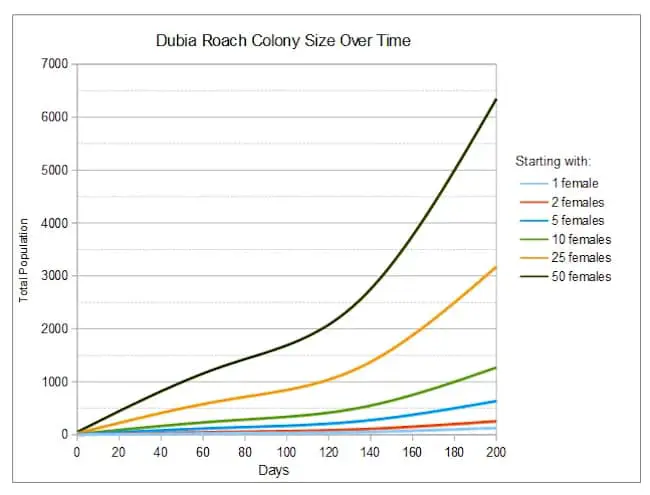
Source: dubiaroachdepot.com
Step 5. Taking care of nymphs
There is no need to make any changes when the first nymphs emerge. When adding change makes it more stressful for the colony and effect breeding results. The care of nymphs can easily be done when leaving them inside the breeding colony. The temperature of 28-32ºC (80-90ºF) is also perfect for newborns. Actually, a stable temperature is very important for them and nymphs can’t handle fluctuations and temperature extremes.
Nymphs do need many proteins in their early stage of life. Important is to leave some frass inside the bin for the nymphs to eat. They will surely eat soon from the food you’re offering to the adults. Just keep enough variation, and they will be doing just fine. Make sure that there is a continuous supply of food and water available to them.
Step 6. Scale-up your breeding setup
You can come to a point to scale-up your breeding setup. There are three approaches to increase your breeding outcome: 1) improve the breeding outcome of the current breeding colony, 2) increase the number of roaches in your colony and 3) add another breeding colony.
1) How can you increase dubia roach reproduction and improve breeding outcome? Temperature is the number one factor. The temperature has to be perfect in the range of 28-32ºC (80-90ºF) and stable. You can also try to better the male to female ratio. The range is 1:3-1:7, but maybe you don’t have that ratio, and if it is 1:3 you should try 1:5 males to females. Try promoting better health of your roaches by making improvements to environment and nutrition.
2) You can also buy additional roaches to enlarge your current breeding colony, or keep more descendants and raise them to mature adults without feeding them to your animals. Over time this will increase your colony and with that increase your breeding outcome. However, make sure you’ll not overpopulate your enclosure. Overcrowding will detriment your breeding result.
3) Another approach is to start a second breeding colony. If this new breeding colony is as big as your current, you’ll double the breeding output for feeder roaches. This approach can be favourable above the previous approach in the way that each enclosure is more manageable and not too crowded.
Ready to get started?
As illustrated in this guide, breeding dubia roaches is easy if you prepare yourself and use the practical tips that are mentioned here. Breeding roaches can be very beneficial to be more cost-effective and raise healthy roaches from the start till feeding them to your animals. Set up breeding bins that suit your situation and buy your first roaches to start your colony.
Do you like to have this practical guide as a hand-out? No problem! You can download it here for free: How to breed dubia cockroaches successfully.
If you are interested in breeding your own feeder insects, you should also check out this practical guide: How to breed (feeder) locusts successfully. An excellent website that provides a lot of information about keeping (feeder) insects is Keeping Bugs. You should definitely check them out!
If you have any question or comment about caring and breeding dubia cockroaches, or to use them as feeder insects, you can e-mail me at info@zoosnippets.com, or you can leave a comment below. I hope this practical guide gives you a head start in creating a healthy and productive breeding colony!
Share this page!